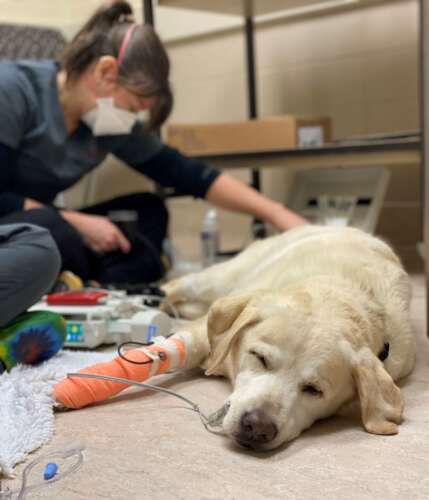
An innovative “seek and destroy” alternative to cancer surgery for people and pets is being tested for the first time this year at the University of Guelph’s Ontario Veterinary College (OVC).
Combining nanotechnology and laser light therapy, the new technique may ultimately offer a targeted, non-surgical way to diagnose and treat tumours while preventing overtreatment and reducing common side effects, said Dr. Michelle Oblak, a veterinary surgeon oncologist and professor in the Department of Clinical Studies.
The first trial on a patient occurred in late February with a 10-year-old beagle named Shiloh.
The treatment combines light-activated nanoparticles called porphysomes along with photodynamic therapy (PDT).
PDT, or use of laser light to destroy tumours, is not new, said Oblak. But this is the first pairing of PDT with this new nanoparticle technology developed by a researcher at Toronto’s University Health Network (UHN).
“This is such an exciting opportunity to have an impact on how cancer is treated in both humans and pets, and to be involved in such an incredibly innovative idea and invention,” said Oblak, whose team plans to recruit 10 canine patients for this year’s clinical trial.
“It’s motivating for us to continue the work we’re doing. This could change the way we treat and diagnose cancer in the future.”
Porphysomes pinpoint tumour location, make tissue vulnerable to laser

For patients in the clinical trial, the OVC team injects the porphysomes into the bloodstream; these nanoparticles collect in the tumour or any spot where the cancer may have spread. The light-activated molecule’s fluorescent glow allows the team to track its location using a special light source.
Besides pinpointing the tumour’s whereabouts, the porphysomes make the tissue more vulnerable to damage from laser light. A beam of near-infrared laser light directed through a nano-fibre activates the porphysome, which then destroys cancerous tissue.
For the clinical trial, the team is destroying only a portion of the tumour, then taking samples of the tumour and lymph nodes to assess results of the therapy. Patients in the trial still undergo standard-of-care surgery to remove the entire tumour.
The OVC team is seeking more dogs with thyroid cancer for clinical trials this year.
Oblak said photodynamic therapy is less invasive than surgery and targets the tumour cleanly without harming normal tissue. The technology also avoids harmful side effects, including neck scarring and nerve damage that may affect the voice. Although these concerns are more prevalent in human patients, pet owners seeking minimally invasive treatment options may view this technology as beneficial for their pets.
She said the technology might also be used in future for tumours difficult to eliminate through surgery. In dogs, this light-activated treatment could be used initially for treating small thyroid tumours as well as other head and neck cancers.
“There’s a lot of interest in this as a non-surgical option,” said Oblak, who is co-director of OVC’s Institute for Comparative Cancer Investigation. “This could really revolutionize many different aspects of cancer treatment and diagnosis.”
U of G team working with UHN head and neck surgery researchers

During the OVC trial, researchers aim to refine the new porphysome treatment for use in animals and, ultimately, this therapy will be used for treating various types of human cancer as an adjunct or alternative to surgery. The U of G team is working with UHN researchers, including head and neck surgeon Dr. Jonathan Irish and Dr. Gang Zheng, the inventor of this technology.
Funded earlier by the Terry Fox Research Institute in Vancouver, Zheng developed nano-sized porphysomes carrying a light-activated molecule. The UHN team tested the technology in rodent and rabbit cancer models during preclinical trials.
Irish said that, pending Health Canada approval and OVC’s results, he hopes to begin a human clinical trial with the technology late this year or in early 2023.
At UHN, the project has also been funded by the Canadian Cancer Society and the Princess Margaret Cancer Foundation.
Irish has worked with Oblak and OVC on several research projects. “This collaboration is a bridge that has been built over the last three years, and we look forward to strengthening that bridge between human health care and veterinary health care,” he said.
Oblak said investigation in dogs with thyroid cancer is a more reliable way to study naturally occurring disease and treatment, adding that canine studies translate more readily than mouse models to human medicine.
Therapy could treat a range of cancers

“This is a great model to understand how porphysomes and PDT work,” said Charly McKenna, research manager for OVC’s veterinary clinical trials and the Veterinary Medical Innovation Program.
The incidence of thyroid cancer in people is increasing worldwide, although long-term survival is excellent in treated patients. Oblak said the therapy might be used ultimately to treat it and a range of other cancers.
Under her Animal Health Partners Research Chair in Veterinary Medical Innovation, this trial is an initiative within the Clinical Translation Platform, which supports health sciences advancement through innovation.
In 2018, Oblak was part of a surgical team that made international headlines for its pioneering use of a 3-D printed custom implant for reconstruction of a dog’s skull following tumour surgery.
Contact:
Dr. Michelle Oblak
veterinary.innovation@uoguelph.ca
